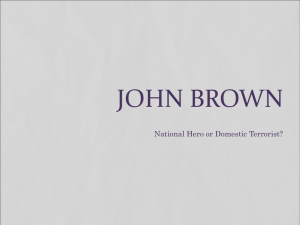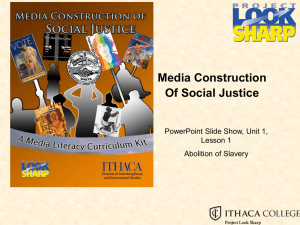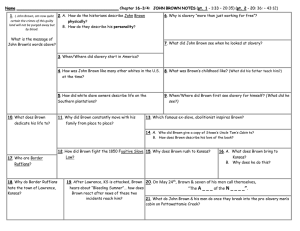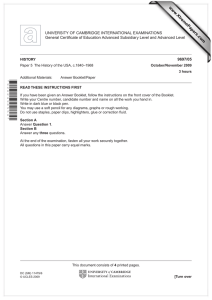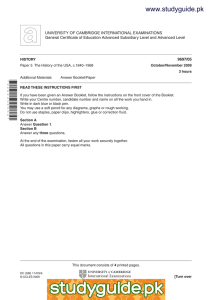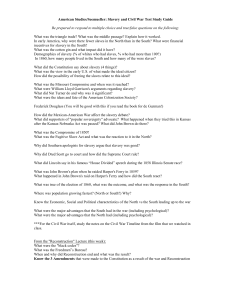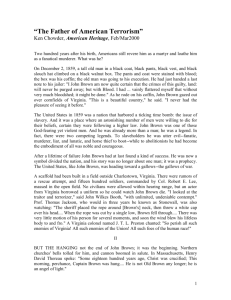1859. John Brown: Martyr or Religious Fanatic? Freedom fighter or... Sources: libwww.syr.edu/digital/exhibits/g/GerritSmith/harpers.htm John Brown, The Making of a Revolutionary
advertisement
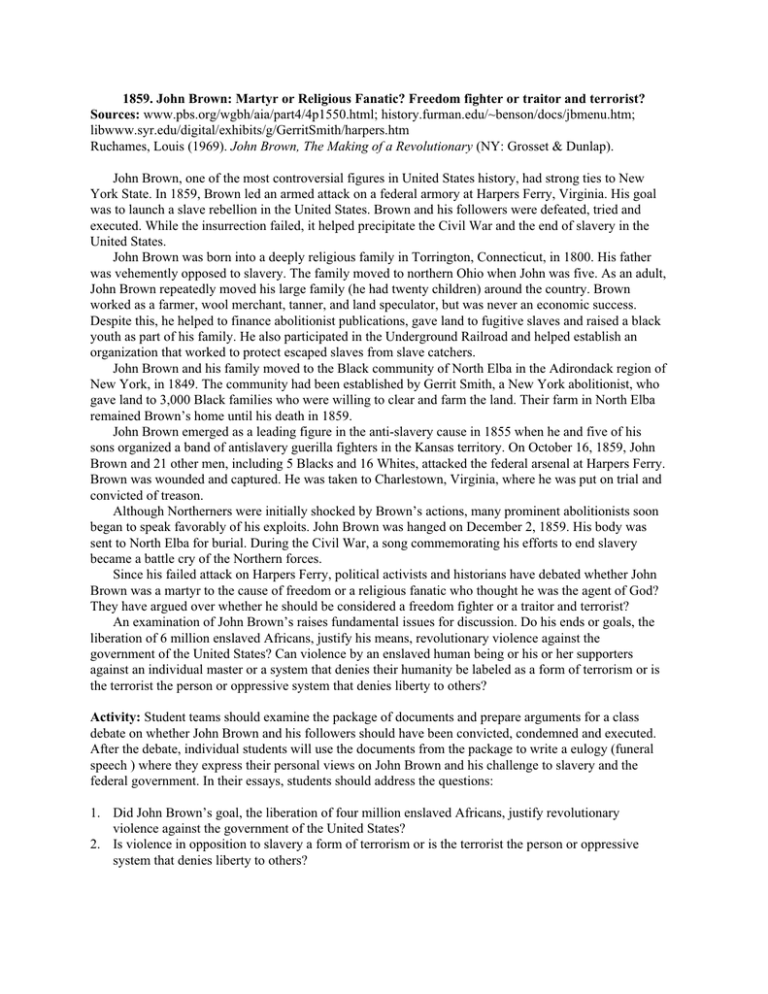
1859. John Brown: Martyr or Religious Fanatic? Freedom fighter or traitor and terrorist? Sources: www.pbs.org/wgbh/aia/part4/4p1550.html; history.furman.edu/~benson/docs/jbmenu.htm; libwww.syr.edu/digital/exhibits/g/GerritSmith/harpers.htm Ruchames, Louis (1969). John Brown, The Making of a Revolutionary (NY: Grosset & Dunlap). John Brown, one of the most controversial figures in United States history, had strong ties to New York State. In 1859, Brown led an armed attack on a federal armory at Harpers Ferry, Virginia. His goal was to launch a slave rebellion in the United States. Brown and his followers were defeated, tried and executed. While the insurrection failed, it helped precipitate the Civil War and the end of slavery in the United States. John Brown was born into a deeply religious family in Torrington, Connecticut, in 1800. His father was vehemently opposed to slavery. The family moved to northern Ohio when John was five. As an adult, John Brown repeatedly moved his large family (he had twenty children) around the country. Brown worked as a farmer, wool merchant, tanner, and land speculator, but was never an economic success. Despite this, he helped to finance abolitionist publications, gave land to fugitive slaves and raised a black youth as part of his family. He also participated in the Underground Railroad and helped establish an organization that worked to protect escaped slaves from slave catchers. John Brown and his family moved to the Black community of North Elba in the Adirondack region of New York, in 1849. The community had been established by Gerrit Smith, a New York abolitionist, who gave land to 3,000 Black families who were willing to clear and farm the land. Their farm in North Elba remained Brown’s home until his death in 1859. John Brown emerged as a leading figure in the anti-slavery cause in 1855 when he and five of his sons organized a band of antislavery guerilla fighters in the Kansas territory. On October 16, 1859, John Brown and 21 other men, including 5 Blacks and 16 Whites, attacked the federal arsenal at Harpers Ferry. Brown was wounded and captured. He was taken to Charlestown, Virginia, where he was put on trial and convicted of treason. Although Northerners were initially shocked by Brown’s actions, many prominent abolitionists soon began to speak favorably of his exploits. John Brown was hanged on December 2, 1859. His body was sent to North Elba for burial. During the Civil War, a song commemorating his efforts to end slavery became a battle cry of the Northern forces. Since his failed attack on Harpers Ferry, political activists and historians have debated whether John Brown was a martyr to the cause of freedom or a religious fanatic who thought he was the agent of God? They have argued over whether he should be considered a freedom fighter or a traitor and terrorist? An examination of John Brown’s raises fundamental issues for discussion. Do his ends or goals, the liberation of 6 million enslaved Africans, justify his means, revolutionary violence against the government of the United States? Can violence by an enslaved human being or his or her supporters against an individual master or a system that denies their humanity be labeled as a form of terrorism or is the terrorist the person or oppressive system that denies liberty to others? Activity: Student teams should examine the package of documents and prepare arguments for a class debate on whether John Brown and his followers should have been convicted, condemned and executed. After the debate, individual students will use the documents from the package to write a eulogy (funeral speech ) where they express their personal views on John Brown and his challenge to slavery and the federal government. In their essays, students should address the questions: 1. Did John Brown’s goal, the liberation of four million enslaved Africans, justify revolutionary violence against the government of the United States? 2. Is violence in opposition to slavery a form of terrorism or is the terrorist the person or oppressive system that denies liberty to others? Documents 1. To the Friends of Freedom, New York Tribune, March 4, 1857. The undersigned, whose individual means were exceedingly limited when he first engaged in the struggle for Liberty in Kansas, being still more destitute and no less anxious than in time past to continue his efforts to sustain that cause, is induced to make this earnest appeal to the friends of freedom throughout the United States, in the firm belief that this call will not go unheeded. I ask all honest lovers of Liberty and Human Rights, both male and female, to hold up my hands by contributions of pecuniary aid, either as counties, cities, towns, villages, societies, churches or individuals. 2. Letter, Rochester, NY, January 30, 1858 (Ruchames, 117-118). My dear wife and children, every one, I am (praised be God!) once more in York State. Whether I shall be permitted to visit you or not this winter or spring, I cannot now say. . . The anxiety I feel to see my wife and children once more I am unable to describe. . . .Do not noise it about that I am in these parts, and direct to N. Hawkins, care of Frederick Douglass, Rochester, N.Y. I want to hear how you are all supplied with winter clothing, boots, etc. God bless you all! Your affectionate husband and father, John Brown. 3. John Brown’s Correspondence with The N.Y. Tribune, January, 1859 (Ruchames, 122-123). On Sunday, the 19th of December, a negro man named Jim, came over to the Osage settlement, from Missouri, and stated that he, together with his wife, two children and one other negro man, were to be sold within a day or two, and begged for help to get away. On Monday, the following night, two small companies were made up to go to Missouri, and forcibly liberate the five slaves, together with other slaves. One of these companies I assumed to direct. We proceeded to the place, surrounded the buildings, liberated by the slaves, and also took certain property supposed to belong to the estate. We, however, learned before leaving, that a portion of the articles we had taken belonged to a man living on the plantation as a tenant, and who was supposed to have no interest in the estate. We promptly returned to him all we had taken. We then went to another plantation, where we freed five more slaves, took some property, and two white men. We moved slowly away into the Territory, for some distance, and then sent the white men back, telling them to follow us as soon as they chose to do so. The other company freed one female slave, took some property, and, as I am informed, killed one white man (the master), who fought against the liberation. . . . Eleven persons are forcibly restored to their “natural and inalienable rights,” with but one man killed, and all “Hell is stirred from beneath.” It is currently reported that the Governor of Missouri has made a requisition upon the Governor of Kansas for the delivery of all such as were concerned in the lastnamed “dreadful outrage.” The Marshal of Kansas is said to be collecting a posse of Missouri (not Kansas) men at West Point, in Missouri, a little town about ten miles distant, to “enforce the laws.” 4. Headlines, New York Herald, October 18, 1859, (Collection of the New-York Historical Society) Fearful and Exciting Intelligence. Negro Insurrection at Harpers Ferry. Extensive Negro Conspiracy in Virginia and Maryland. Seizure of the United States Arsenal by the Insurrectionists. Arms Taken and Sent into the Interior. The Bridge Fortified and Defended by Cannon. Trains Fired into and Stopped --- Several Persons Killed --- Telegraph Wires Cut --Contributions Levied on the Citizens. Troops Dispatched Against the Insurgents from Washington and Baltimore . . . . 5. The Trouble at Harper’s Ferry, Albany Evening Journal, October 18, 1859 The telegraph during the past twenty-four hours has brought startling accounts of an "insurrection" at Harper's Ferry. But the details are confused, and the origin of the riot is entirely unexplained. Whether it is a revolt of the slaves, or a strike of the workmen, or a lawless outbreak from some other cause, seems purposely concealed. Harper's Ferry is a town about the size of Cohoes, situated at the junction of the Shenandoah river with the Potomac, and where the united stream passes through an opening in the Blue Ridge. It is 178 miles north of Richmond, and of course on the line which separates Virginia from Maryland. A United States Armory is situated here, employing 250 hands, and turning out eight or nine thousand small arms annually. There are usually kept on hand some 80 or 90,000 stand of arms, enough to make a mob that has seized them a formidable foe. The Chesapeake and Ohio Canal and the Baltimore and Ohio Rail Road both pass through this place. The latter crosses the Potomac on a bridge 750 long, connecting the town with the Maryland side. 6. The Trouble at Harper’s Ferry, Albany Evening Journal, October 19, 1859 At last we have more definite information as to the origin of the outbreak at Harper's Ferry. It seems that some fifteen or twenty misguided and desperate men engaged in a plot to bring about a revolt of the Slaves. Nor did they stop at the crime of seeking to plunge a peaceful community into the horrors of a servile insurrection. Seizing Government arms and turning them against Government officers, they intended, if they did not accomplish Treason, of the gravest sort. But as might be expected, the attempt failed to gain supporters; the entire community was thrown into a panic, and an overwhelming force of Troops, of the State and the United States, a hundred to one, crushed the riot, and either shot down the rioters or took them prisoners.. . . None but a madman could seriously expect that twenty men could make head against the whole Union, and none but those whose sense of justice was blunted by deep passion could fail to see that they were committing a crime against Innocent men, women and children, which would inevitably meet, and justly deserve, universal condemnation. 7. The Harper's Ferry Outbreak Albany Evening Journal, October 27, 1859 The Democratic press are doing their best to make it appear that "Old Brown's" insane invasion was countenanced by leading Republicans. But they are hard put to it for material for evidence. Yesterday they spread abroad on the wings of the telegraph, that "correspondence with HORACE GREELEY" had been discovered in "Old Brown's" carpet-bag. The foundation for this was merely a business memorandum that he had once subscribed to the New York Tribune! 8. Manifesto of the New York Democratic Vigilant Association to their fellow citizens of the State and Country, New York Times, October 27, 1859, p. 1. At a meeting of the Executive Committee of the New York Democratic Vigilant Association, held on the 18th inst., a Committee was unanimously appointed, on the motion of Mr. Royal Phelps, “to collect the details of the history of the affair at Harper’s Ferry, and if it prove that there be any connection between the conspirators and any political body at the North, that ______ sum of money be appropriated to disseminate the facts, and to make known to our Southern brethern our utter condemnation of the instigators of the movement. 9. Address of John Brown to the Virginia Court at Charles Town, Virginia on November 2, 1859 In the first place, I deny everything but what I have all along admitted, -- the design on my part to free slaves. . . . Had I so interfered in behalf of the rich, the powerful, the intelligent, the so-called great, or in behalf of any of their friends -- either father, mother, sister, wife, or children, or any of that class -- and suffered and sacrificed what I have in this interference, it would have been all right; and every man in this court would have deemed it an act worthy of reward rather than punishment. The court acknowledges, as I suppose, the validity of the law of God. . . . I believe that to have interfered as I have done -- as I have always freely admitted I have done -- in behalf of His despised poor, was not wrong, but right. Now if it is deemed necessary that I should forfeit my life for the furtherance of the ends of justice, and mingle my blood further with the blood of my children and with the blood of millions in this slave country whose rights are disregarded by wicked, cruel, and unjust enactments. -- I submit; so let it be done! 10. Albany Evening Journal, November 30, 1859 John Brown will meet his fate, whether as a bad man or as a madman, with comparative little sympathy. Our own belief is that he should not be executed; but if the seeds of future excitement are planted on his tomb, we do not doubt it will be found that they were placed there as well by his Southern enemies as by his Northern sympathizers. Whatever of sympathy the fate of John Brown awakens, will be occasioned by his bearing through an ordeal so trying, rather than any complicity of feeling in his lawless enterprise. Upon the question whether he had any right to go there with such intentions, or whether, when taken, he ought to be punished, there is no general difference of opinion or sentiment. Though we "would that all men" were Free, we should as readily go to Virginia to run off their Horses and Cattle, as their Slaves. By the Constitution and Laws, Slavery is recognized and tolerated. It was a compact made by our Fathers, and one that binds their heirs. We will oppose both its extension and its encroachments. Thus far, and no farther, goes our sense of duty to Freedom. 11. The Execution of John Brown, Albany Evening Journal, December 1, 1859 Already, the muttered thunder of a pent-up sympathy is heard. The pulpit, the platform and the press, have already spoken with most intense emphasis. . . . But should John Brown be hung, the feeling will be augmented an hundred fold; and hatred of Slavery will become the predominant emotion in the breasts of millions who have thus far had neither fellowship nor sympathy with those who seek to goad the South into just such exhibitions of weakness and folly as these executions will afford. 12. Last Words of John Brown, December 2, 1859 (Ruchames, 167) I, John Brown, am now quite certain that the crimes of this guilty land will never be purged away but with Blood. I had as I now think vainly flattered myself that without very much bloodshed it might be done. 13. John Brown’s Execution, The New York Times, December 2, 1859, p. 4. It is idle to blink the fact that John Brown, who dies today as a criminal in Virginia, will be honored and lamented today as a martyr by thousands of men and women in Northern States. . . .All that is left to be done in the matter now by Northern men who love their country and would see the rights of all sections justly maintained, is to protest against the extravagant and inflammatory use which fanatical and reckless men at the North will now be swift to make of this decision and this deed in Virginia. . . . [I]f we mean this Union to endure as a great national system, founded upon the equality and fraternity of the States, we must carefully repudiate and to the best of our abilities repress the sympathy which thousands of easy enthusiasts will now be hastening to offer to the memory of a man in whom Virginia can only see the invader of her established order, and the implacable enemy of the social institutions by which she will choose to abide. 14. Public Expressions of Sympathy, The New York Times, December 3, 1859, p. 3. The small lecture room of Dr. Cheever’s Church was filled yesterday morning, it being announced that a prayer meeting for John brown would be held. . . . Mr. Tappan made a prayer, speaking of brown as a Christian martyrin the hands of an infuriated mob, and praying that posterity would rise up and call him blessed. . . . .A large assemblage, nearly all colored persons, filled the Shiloh (colored) Presbyterian Church, yesterday, forenoon. After singing, Rev Charles B. Rae offered a prayer asking that God would rouse the consciences of men to see the wrongs done by the banditti of slaveholders as they never had been seen before, and that God would be with the wife and children of Mr. Brown, and with all his friends and acquantances in this day of trial. 15. Rev. Henry Ward Beecher’s Response to the attack on Harpers Ferry We have no right to treat the citizens of the South with acrimony and bitterness because they are involved in a system of wrong doing . . . .The preaching of discontent among the bondsmen of our land is not the way to help them . . . . No relief will be carried to the slaves or to the South as a body by any individual or organized plans to carry them off or to incite them to abscond . . . . If we would benefit the African in the South we must begin at home. No one can fail to see the inconsistency between our treatment of those amongst us who are in the lower walks of life and our professing of sympathy for the Southern slave . . . We must quicken all the springs of feeling in the free states on behalf of human liberty . . . We must maintain sympathy and kindness toward the South . . . . You should care for both the master and the slave . . .You ought to set your face against and discountenance anything like an insurrectionary spirit. 16. William Cullen Bryant, editor of the New York Evening Post, Responds to John Brown’s attack on Harpers Ferry “The great body of the northern people have no desire nor intention to interfere with slavery within its present limits, except by persuasion and argument. They are unalterably opposed to the spread of it, as the south ought to be, but they are willing to leave the extinction of it in the states to the certain influences of commerce, of good sense, of the sentiment of justice and truth, and the march of civilization.” 17. Northern Sentiment, The New York Times, December 5, 1859, p. 4 The following paper is in circulation for signatures in this City: “Justice from the North. – The undersigned, citizens of new York, desirous of vindicating the North, and expressing their sympathy with the men of the South in the present crisis, and their abhorence of the motives and acts of John Brown and his followers, in their assault upon the peace, safety, lives and property of their fellow citizens of Virginia, and in favor of giving a public expression of rebuke to the dangerous and revolutionary doctrines now currently taught, . . . are in favor of calling a public meeting in this City at an early day, to give expression to the above sentiments. 18. Reverend Theodore Parker, Letter to Francis Jackson, November 24, 1859 (Ruchames, 254265). Theodore Parker was a strong supporter of John brown. In this letter, written in defense of the attack on Harpers Ferry, Parker defends to right of slaves and their supporters to armed rebellion. 1. A man held against his will as a slave has a natural right to kill every one who seeks to prevent his enjoyment of liberty. 2. It may be a natural duty of the slave to develope (sic) this natural right in a practical manner, and actually kill all those who seek to prevent his enjoyment of liberty. 3. The freeman has a natural right to help the slaves recover their liberty, and in that enterprise to do for them all which they have a right to do for themselves. 4. It may be a natural duty for the freeman to help the slaves to the enjoyment of their liberty, and as means to that end, to aid them in killing all such as oppose their natural freedom. 5. The performance of this duty is to be controlled by the freeman’s power and opportunity to help the slaves. 19. Wendell Phillips, eulogy at the funeral of John Brown, North Elba, New York, December 8, 1859 (Ruchames, 266-269). I feel honored to stand under such a roof. Hereafter you will tell children standing at your knees, “I saw John Brown buried, - I sat under his roof. . . . God make us all worthier of him whose dust we lay among these hills he loved. Here he girded himself and went force to battle. Fuller success than his heart ever dreamed God granted him. He sleeps in the blessings of the crushed and the poor, and men believe more firmly in virtue, now that such a man has lived. Standing here, let us thank God for a firmer faith and fuller hope. 20. Henry David Thoreau, The Last Days of John Brown, delivered, July 4, 1860, North Elba, New York (Ruchames, 272-277). RJohn Brown’s career for the last six weeks of his life was meteorlike, flashing through the darkness in which we live. I know of nothing so miraculous in our history. . . . Years were not required for a revolution of public opinion; days, nay hours, produced marked changes in this case. Fifty who were ready to say, on going into our meeting in honor of him in Concord, that he ought to be hung, would not say it when they came out. They heard his words read; they saw the earnest faces of the congregation; and perhaps they joined at last in singing the hymn in his praise. 21. Frederick Douglass, Harpers Ferry, West Virginia, May 30, 1881 (Ruchames, 278-299). Did John Brown draw his sword against slavery and thereby lose his life in vain? . . To this I answer ten thousand times, No!. . . . John brown began the war that ended American slavery and made this a free Republic. Until this blow was struck, the prospect for freedom was dim, shadowy and uncertain. The irrepressible conflict was one of words, votes and compromises. When John Brown stretched forth his arm the sky was cleared. The time for compromises was gone – the armed hosts of freedom stood face to face over the chasm of a broken Union – and the clash of arms was at hand. The South staked all upon getting possession of the Federal Government, and failing to do that, drew the sword of rebellion and thus made her own, and not brown’s, the lost cause of the century.
